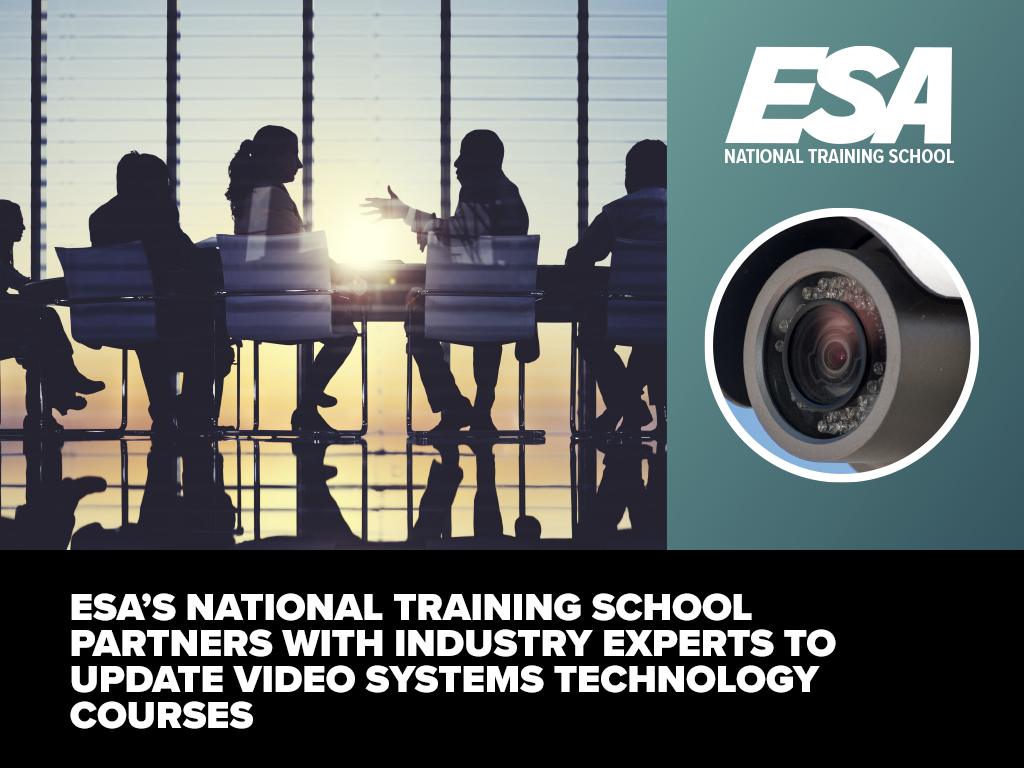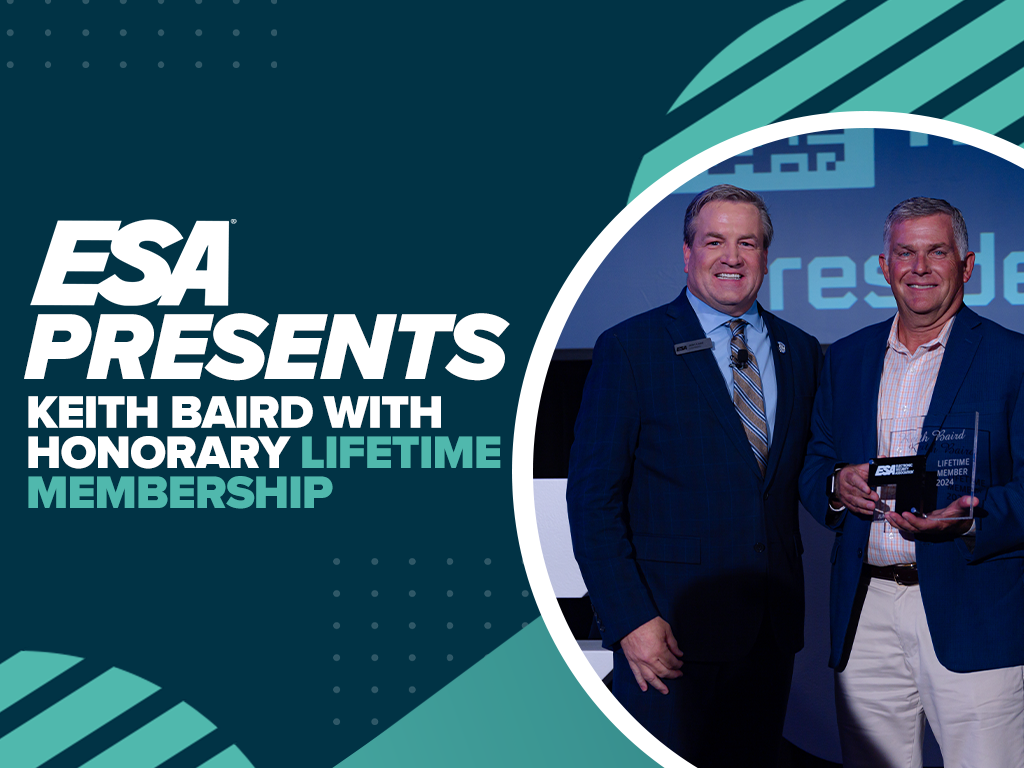ESA National Training School Partners with Industry Experts to Update Video Systems Technology Courses

This summer of 2023, ESA asked a team of respected industry professionals to help update the ESA National Training School Video System Technologies education program.
We spoke with the program contributors to learn more about their industry experience and expertise. As well as to gain further insight into why the program changes were deemed necessary. Casey Williams is the Sr. Product Enablement Manager at ADT Commercial.
Steve Macmahon
Steve Macmahon currently serves the industry as Training Manager for Securitas. A locally focused security company that helps organizations of all sizes improve their security programs and results in the US.
Macmahon has witnessed significant changes over his 45 years in the security industry. Serving in roles ranging from field operations to business owner and vendor-certified trainer on a variety of control, video, and intrusion platforms. He strives to approach all technical training with a field technician’s perspective. During this time, Macmahon has noticed that video systems are some of the fastest changing areas in the industry.
“Video technology is advancing at a rapid rate, and it is important to stay current with new technology and solutions. The foundation of video platforms and systems have not really changed but the primary components and solutions change daily.” –Steve Macmahon
Due to this, technicians in security need to keep up with ever-changing systems in the video technology field even more diligently than other fields. Expanding their knowledge and training as the video industry continues to evolve from coas analog solutions to enterprise-level IP solutions and beyond. Viideo Systems Technology courses at the ESA National Training School provide technicians with the tools they need to do just this.
Macmahon has set himself the goal of passing along knowledge while mentoring technicians and customers to help them achieve success. When asked to contribute to the VST course update, he saw another opportunity to continue helping technicians develop their careers.
Steve Riley
With over 32 years of experience in the world of cloud security, Steve Riley is an ESA National Training School Instructor. As well as a Field CTO at Netskope, a global cybersecurity leader. Who’s redefining cloud, data, and network security so organizations can apply zero trust principles to data protection. Netskope’s Intelligent Security Service Edge (SSE) platform provides fast, easy to use, and secure.
Since technology is evolving on a constant basis, Riley is dedicated to keeping coursework up-to-date and relevant. Striving to maximize time by eliminating old or irrelevant information.
Early on in his career, Riley took his first ESA course and began working in construction, pulling wire and learning how to do framing. Over time, he moved to commercial installation and service. Where he used video systems ranging from a single small camera with a monitor to intricate network systems. For the last 12 years, he’s been committed to helping technology innovators. Like creating multiple platform wireless IoT cameras and expand technician training. The young people of the industry will lead us into the next century. Instructors should take the opportunity to help them grow as a way of giving back to them for what they will do– and what they’re already doing.
Riley believes training like the VST courses at the ESA National Training School are critical for technicians’ careers.
“Technology is saving customers and business money. So, it’s critical for technicians to have a thorough understanding of those technologies to ensure their longevity in the industry. As well as a competitive edge over others in the industry.” –Steve Riley
Michael Slossar
Another contributor to the course update was Michael Slossar, Licensing and Compliance Risk Manager for Global Life Safety Alliance. Slossar began his career in 1982, working in residential security with Leonard Security. For the last 12 years, he, too, has been working in development. Specifically for software and equipment design. He has stayed involved with various associations serving across various aspects of Security and Life Safety.
Slossar recognized that the ESA VST Courses needed IP and IoT elements added, and old technology removed. With the exceptions of a few for historical purposes.
“In order for a technician to stay competitive in this industry they must grow into parallel careers such as Internet Technology (IT) Networking, and internet security. Understanding these things will create job security for a technician and confidence for a business owner.” – Michael Slossar
Slossar is always on the lookout for volunteer opportunities. So, when he saw the chance to contribute to the VST Course updates, he jumped at the chance to put his experience to use. By volunteering, he also gets the broader exposure to people in the industry and
gains more knowledge, which he can share with others.
Tom Ingles
Tom Ingles, Director of Operations for Brinks Home Security, also collaborated in the course updates. Firmly agreeing with the others that video systems must be updated often to keep up with ever changing technology. The role video plays in security plans continues to
grow. As are customer expectations, so companies that adopt new technology and update their training programs have an automatic competitive advantage in the marketplace. With his 8 years of experience installing and servicing video systems, managing operations, and testing and selecting new products, Ingles should know.
This course has been updated to focus on IP video, reflecting the current market, and includes installation standards instruction for video equipment and wiring.
“I appreciate the opportunity to contribute to the development of industry training courses from an organization like ESA, which is a tremendous resource for security dealers.” – Tom Ingles
Larry Mullins
Larry Mullins is the Commercial Engineering Manager at Brinks Home Security and has been in the industry for 38 years, during which he’s worked in service, installation, inspection, testing, sales, and design. Currently, he’s responsible for code compliance and serves on several industry committees.
Mullins emphasizes how important it is for technicians to be trained on the products they are installing and servicing in order to provide top-quality services. They should understand how these devices operate and ensure that all systems are in accordance with applicable codes and standards.
Mullins decided to be involved in the Video Systems Technology Course to help remove outdated information and to ensure that we are offering the most recent and relevant training possible.
“At this stage of my career, I feel it’s important to share what I have learned. In this industry, we may not be first responders, but what we do is important and can save a life, or at the very least, give someone peace of mind that they are protected.” –Larry Mullins
Kile Unterzuber
Another contributor was Kile Unterzuber, a North Carolina Burglar and Fire Alarm Association member. Bringing over 43 years of experience in the industry. Starting with audio and video production in the 1970s, Unterzuber has provided witness and consulting services in video forensics cases. Striving to keep up with all new developing equipment and video technologies, Unterzuber is eager to share his professional expertise with others in the industry.
Since digital video is critical in the investigation of crimes, property damage, vehicular accidents, and industrial incidents, Unterzuber believes it is critical for system integrators to understand system design, installation, and maintenance. End users want results from video systems but don’t have the knowledge to set them up and manage them correctly. Unterzuber himself has had to review a ton of video shot from a physical camera from a computer monitor simply because the end user didn’t know how to export videos from the system. A fully trained technician can help anticipate these kinds of needs and address them early on by designing and setting up the system accordingly and providing customer training. Additionally, having the skills and knowledge to make the right decisions in choosing and implementing video systems effectively will help technicians greatly reduce risk and liability.
“Forty years ago, we did not have the on-line training and resources that we do now. Developing and presenting quality training materials is more important than ever.” – Kile Unterzuber




